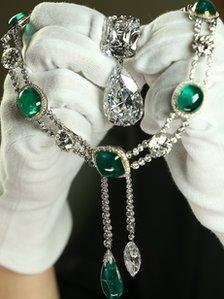Jewellery from world's largest diamond to go on display
- Published

The diamond was cut into nine principal stones
Jewellery made from the world's largest diamond is to go on display as part of the Queen's Diamond Jubilee.
The exhibition reunites for the first time seven of the nine principal stones cut from the Cullinan Diamond.
The seven stones are set in brooches, a ring and a necklace, most of which have been worn by the Queen during her 60-year reign.
The exhibition starting on 30 June will form part of the summer opening of Buckingham Palace later this year.
'Worthless crystal'
The show includes a number of the Queen's personal jewels and illustrates the many ways in which diamonds have been used and worn by British monarchs over the last two centuries.
The Cullinan Diamond, which weighed 3,106 carats in its rough state, was discovered at the Premier Mine near Pretoria, in South Africa in 1905.
It was named after the chairman of the mining company, Thomas Cullinan.
Exhibition curator Caroline de Guitaut said: "Until 26 January 1905 no one had ever seen a diamond of this size.
"So incredible was its discovery that the moment it was found at the Premier Mine it was thrown out of the window of the mine manager's office because it was thought to be a worthless crystal.
'Now, for the first time, our visitors will be able to see seven of the nine principal stones cut from this magnificent and highly important diamond.'
Measuring 10.1cm high, the diamond was notable for its extraordinary blue-white colour and exceptional purity.
Although it is the largest ever to have been found the rough diamond had a cloven face on one side, which suggested that it might once have formed part of an even larger stone.
Public wonder
The collection includes a diamond crown that was worn by Queen Victoria
Soon after being discovered, it was sent to London and taken to Buckingham Palace for inspection by King Edward VII.
For the next two years the stone remained a public wonder and was shown to many prospective clients - although no buyer could be found because nobody knew how it could be cut.
Eventually the Prime Minister of the Transvaal suggested that his government should acquire the Cullinan and present it to Edward VII as a token of loyalty.
In 1907, under police protection, the uncut stone was conveyed to Sandringham House, in Norfolk, where the King was celebrating his 66th birthday.
The gift did not include the cost of cutting the stone, and this task was entrusted to the celebrated firm of IJ Asscher of Amsterdam.
The company produced nine principal stones, 96 smaller stones and nine carats of unpolished fragments.
The two largest gems form part of the Crown Jewels - one is set at the head of the Sovereign's Sceptre and the other into the Imperial State Crown.
The other seven were mounted in various settings for Queen Mary, wife of George V.
The exhibition will run from 30 June to 8 July and then from 31 July to 7 October.